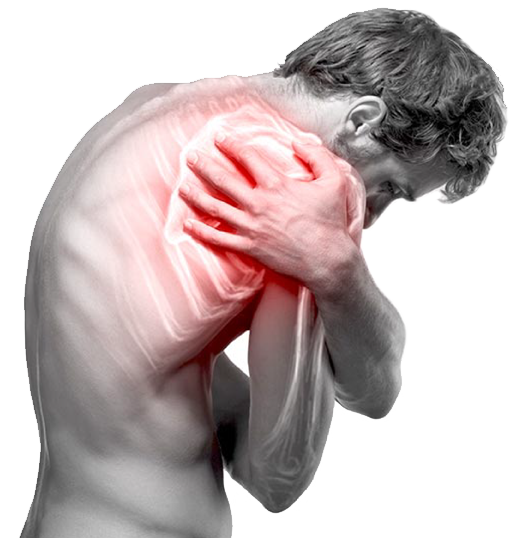Trigger Point

Trigger Point
Overview
Trigger points are focal points found in the muscle spasm located in the upper back and the areas around the shoulder. The common sites for trigger points are trapezius and rhomboid back muscles, which can be found in the I the upper areas of the shoulder areas. The trigger points can cause pains around the shoulders, neck, and head. The trigger points not only occur in the lower back but the upper spine. Trigger points can cause recurrent pain and inactivity, and can significantly lower quality of life. Muscle pains matter and they are a common medical complaint and the main cause are trigger points. They are important aspects in headaches, low back pain and neck pains. There are two types of trigger points, latent and active. Active trigger points refer pain to other body parts and that is why you may experience a headache that is caused by neck pain, low back pain or pain in the shoulder.
Conditions Treated
Trigger point injection is mainly used to relieve myofascial pain. Myofascial pain is a severe musculoskeletal pain in which the pain erupts within the muscles and fascia which causes referred and local pain, autonomic nervous system dysfunction or a restricted variety of motion.
Some other pain condition that can be treated by TPI is fibromyalgia. This is a chronic condition which results in a widespread pain, sleep complications, fatigue, and distress. A chronic condition involving widespread pain, fatigue, sleep abnormalities, and often distress.
TPIs can be issued to patients with pain in the head to control a headache. Currently, trigger points are being examined for its treatment for whiplash. Whiplash is an acute condition which involves neck pains which are caused by a sudden forward and backward motion. An acute condition involving neck pain after sudden backward and forward motion.
The procedure / What to expect
The procedure involves a doctor exerting mild pressure upon a trigger point with an objective of observing a muscle twitch and evaluating the patient’s pain. This can be done by hand if special equipment. The sole reason for this evaluation is to allow the health practitioner to identify the muscles that cause pain which could benefit from the injections. After the identification of the painful area, the doctor will use a small needle to insert medication into the trigger points. A small amount (0.2 mL) of anesthetic should be injected once the needle is inside the trigger point. The common sites that can be used to pass medication are legs, arms, neck, and low back. The medication includes a synthetic steroid (corticosteroid) and local anesthetic (painkiller). This medication is done in concert to lower the inflammation and diffuse the trigger point. In some few cases, no injection of medication is done. This is only referred to as dry needling it has proved to be effective in certain patients. To make sure that the needle is not near any blood vessel the plunger should be removed before the injection is done.
Before inserting the needle into the trigger points, the doctor will warn the patient of the possibility of the sharp pain, unpleasant satisfaction or twitching. The needle is then removed to the level of a subcutaneous tissue the redirected inferiorly and superiorly, medially and laterally, repeating the injection and needling process in all sides until the local twitch response is not produced or repelling muscle tautness is no longer apparent. In case of a chronic low back pain, the doctor should include gluteus medius trigger points in the procedure.
Benefits
A series of studies have revealed that Trigger point injection is helpful in improving the quality of life of patients who experience neck pain and back pains caused by myofascial pain syndrome. Patients who undergo this procedure have a quick recovery time, a minimal risk of infection and other risks such as scarring, and outpatient setting. There are very many benefits of trigger point injection. It offers you an option of not undergoing surgery as a medical option for the pain. Trigger points can be painful and can cause disturbance to your health. It is therefore important to seek medical advice from a health practitioner. In case you release you suffered from the trigger point. Another benefit of this therapy is that it’s connected directly to the patient’s pain they are experiencing. The personalized treatment plan ensures that the pain is well-taken care off in an efficient manner.
Although the patients who undergo this pain relief experience some pain and discomfort, the releasing of the trigger point is quite critical in your health. After the procedure, you will start to see improvement in your health and the level of energy will also increase as times go by. Although this may not be the case for all the patients, you should be able to notice the changes and improvement in the level of pain after the first treatment.
How does it work
Trigger point injection involves injecting medication into trigger points as mentioned above or knots that form when muscles have not relaxed. This procedure should be carried out under a sterile technique, and only by Board Certified Pain Specialists.
How many treatments do I need?
Typically, a trigger point is relieved after one procedure. This mainly happens with patients who have a remote trigger point. Additionally, it happens with patients who experience trigger points, and its main cause has been removed. An example is the trigger points that result from continues minor trauma or movement that cease to be performed. The trigger points such as those that result from chronic conditions fibromyalgia and myofascial pain syndrome often occur due to the problem underneath. In this cases, it is advisable to have the trigger points administered as regularly as possible. The number of time the procedure is done on a patient depends on the medication being scheduled. If lidocaine or a mixture of anesthetics are used, the procedure will be done as frequently as monthly. In case a steroid is Injected then the trigger point injection should be administered few times at the discretion of the doctor,
because of the risk of tissue damage or shrinkage from the steroid medication.
Post-injection procedure
After the procedure, the region is palpated to confirm that there exist no tender points. In case other tender trigger points are palpable, they are to be separated from the rest, needled and injected. Pressure is exerted at the needled areas for two minutes or so to cause hemostasis. For skin protection, an adhesive bandage can be used. A study was done recently reveal that in the case of stretching the affected muscle just after the needling may increase the effectiveness of the trigger point injection. Travel advice that you can do this by advising the patient to move the injected muscle through its full range of motion about three times to reach to its fully lengthened and shortened point in each cycle.
After injection, soreness occurs in most cases, and the patient may notice the pain relief after injection. Continuous examination of the injected areas may be required. One thing that is not advised is the reinjection of the trigger points. This should not be done until, the [post injection soreness has subsided, which mainly takes three to four days. It is not aloe recommended for a reinjection to be done to a muscle that has had two to three unsuccessful attempts. It is important to be active and keep the muscles in a full state of motion the week after the procedure. You should also avoid vigorous action, especially in the forts three to four days after the dose.
When will I feel better
Many patients who have been under the procedure have reported having the pain relief after just the initial procedure. For some few patients, several treatments are required before the pain starts to reduce. It is common for you to receive some soreness for a few days after the procedure. This usually resolves after the first few treatments. You may also experience some fatigue as the pain muscled the given time to relax and resume to the normal state.
As the stress of the musculature moves and goes into an abnormal balance, pain patterns may change. This is a temporary and healthy stage of recovery from chronic pain. It is common for patients to find relief of pain they were not in to be treated. This can be forearm pain, chronic hand. For you to resume your normal routine, it is based on the self-care program issued to you by the health practitioners. One of the best ways of alleviating pain is to minimize the stress, avoid overexertion and try low- impact, friendly exercises.
Is this procedure right for me? What are the risks/benefits?
A common complication after the procedure is as post-injection pain. This rarely happens, but it can occur in some patients. However, the pain subsides after some few days. This effect is mostly experienced in patients who had dry needling. This is when there is no medication inserted into the trigger points. To lessen this pain, you can apply an ice pack, or pain medication such as ibuprofen, acetaminophen or naproxen sodium.
In case you have a steroid injected into the trigger points, then there is the possibility of a shrinkage of fat that lies beneath the skin which may leave a depression o the surface of the skin.
Other complications may include infection such as septic arthritis, spondylodiscitis, necrotizing fasciitis, epidural abscess, and osteomyelitis.
Some other reported risks are peripheral nerve, spinal cord injury, air embolism, chemical meninges and tendon and fascial ruptures.
Request an appointment
We are experts in minimally invasive procedures with zero downtime, allowing you to resume regular activities the same day. Leave us your information, and we will reach out to help you verify your insurance coverage, and schedule an appointment with one of our vein specialists. We are a non-participating provider with BCBS, empire, Aetna, GHI, Cigna, United Healthcare, Oxford, BCBS Horizon, Magnacare and we will work directly with your insurance company to help you get treated with no surprise bills.
